December Itinerary in Japan Day 3 (Aomori / Akita Meal edition)
(Monday, December 13th)
Table of contents
1. Nakamiso
While visiting sightseeing spots, I had miso ramen at “Nakamiso” in the basement of the Nakasan Hirosaki store. The unusual store name “Nakamiso” was changed to “Nakamiso” because it was “Miso Ramen” that was born in the basement of “Nakasan Department Store”. “Nakamiso” was originally called “China Doll”. It’s interesting to change the store name to a completely different name.

The reason I went to “Nakamiso” was because I found an online article saying that “Nakamiso” is a favorite local dish of Hirosaki citizens. Certainly, when I went to “Nakamiso” in the basement of the Nakasan Hirosaki store, it was crowded with many customers even after 11 o’clock. When observing the orders of local customers, there were several people who asked for two small sizes of ramen with two flavors.
Also, when I looked it up after the trip, it seems that “Nakamiso won the first place in the” 1st Hirosaki Ramen Project “held from December 2020 to February 2021.” Furthermore, in May 2021, it was certified as a hometown tax refund item in Hirosaki City. It is a local dish that Hirosaki citizens love, which is approved by the government.
When I tried the “Nakamiso” miso ramen, it was delicious with plenty of vegetables. However, I personally wanted a little more body. However, the medium size of miso ramen with plenty of vegetables is relatively cheap at Yen 630, which is wonderful as a local dish of Hirosaki citizens who will eat it regularly.
The department store called Nakasan is based in Aomori prefecture, and its main store is the Hirosaki store. It was founded in Goshogawara City, Aomori Prefecture as a Nakasan kimono store.
2. BRICK A-FACTORY
I had apple pie and raw cider at “BRICK A-FACTORY” on the 2nd floor of Hirosaki station. “BRICK A-FACTORY” is a new store that just opened in April 2021. Raw cider was 150 ml and was Yen 500. I don’t usually drink cider, but I think that 500 yen is very expensive for 150 ml. As I thought when tasting “A-FACTORY” in Aomori City, cider is a high-priced drink, isn’t it? I thought it would be easier to drink if I had a cheaper cider.
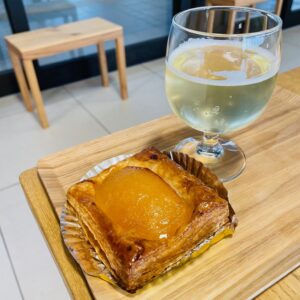
The apple pie was supervised by the pastry shop “Bonjour” (Hirosaki City) and was very delicious. I thought the apple pie Yen 330 was a reasonable price.
3. Craft beer
I bought a canned beer of “Menkoi Weizen”, a craft beer of “Be Easy Brewing“, at the station building “Applies” of Hirosaki Station. I drank canned beer on the train to Akita. “Menkoi” means Tsugaru dialect and cute. The woman depicted on the canned beer is a model from Hirosaki. “Menkoi Weizen” was an easy-to-drink and delicious beer with the aroma of bananas and cloves unique to Weizen beer.
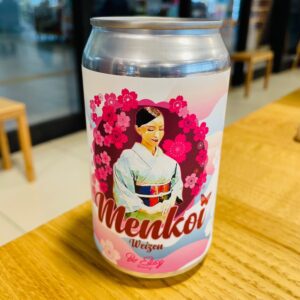
“Be Easy Brewing” also sells “Nakonashii Golden Ale” as a product. “Nakonashii” means Tsugaru dialect and close friendship. The beer naming that conveys the love of Tsugaru by Gareth Anson Burns, the founder of “Be Easy Brewing”, is wonderful.
A large apple object is displayed next to the ticket gate at Hirosaki Station. As expected, Hirosaki is a city of apples.
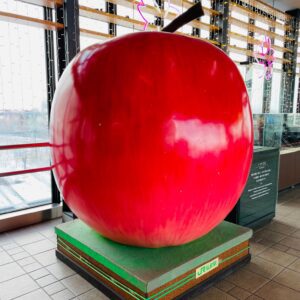
4. Toppin Pararinopu
After arriving at Akita Station and checking in at the hotel, I had dinner at the izakaya “Toppin Pararinopu”. The meaning of “Toppin Pararinopu” is Akita dialect, which means “Happy end”, “Yes, this is the end” and so on.
The izakaya “Toppin Pararinopu” has robatayaki (called “Genshi-yaki” in “Toppin Pararinopu”), and you can enjoy delicious local dishes, seafood, meat dishes, etc. in a very nice atmosphere.

The combination of Otoshi ( small appetizer ) and Akita Prefecture’s craft beer “Tazawako Beer” Alt was also very delicious.
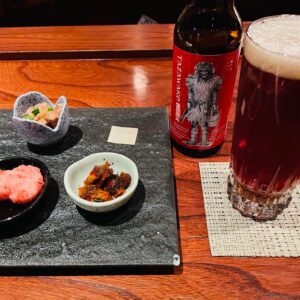
I ordered 2 pieces of sashimi (Kagamidai “Mirror dory” , Greater Amberjack), Yaki Shiitake Mushroom, and Yaki Hatahata (Japanese sandfish).
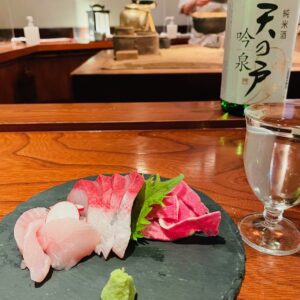
Kagamidai (left side of the above photo) is a fish caught mainly in Akita prefecture, but it is a rare fish with a very small catch. The season for Kagamidai is from October to February, so I was able to eat precious Kagamidai sashimi just during the season. Although it had a light taste, it tasted so good that it was chewed, and it was a very delicious fish.
The yaki shiitake mushrooms were also thick, juicy and very delicious.
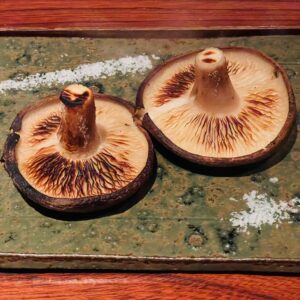
Grilled Hatahata is baked at the fireside using precious raw Hatahata that is not frozen. It is no exaggeration to say that I went on a trip to Akita in December to eat Hatahata. Hatahata fishing is a very valuable fish with a catch quota that can only be operated for 12 to 17 days coast and 22 days offshore. Especially in recent years, poor fishing has become conspicuous, and it is becoming difficult to eat raw Hatahata even in Akita. In particular, the catch of females with eggs seems to be decreasing. The bubble wrap texture of the large egg (Brico) was the best.


Japan Fisheries Co-operative has selected “Akita Hatahata” as the “PRIDE FISH” for winter in Akita Prefecture. Hatahata is written in Chinese characters as “thunder” in the fish edition and “god” in the fish edition. It is said that thunder is used because there are many thunders in Akita prefecture during the Hatahata fishing season in November. In addition, it is said that the Chinese character of God is a fish of God’s grace because fish that normally do not appear at all suddenly rush in a large group before the New Year. Both Hatahata’s Chinese characters have a romance.
“Toppin Pararinopu” has a large selection of sake recommended by sake masters, and it also teaches us how it goes well with food. It is an izakaya that I can recommend to everyone with confidence.
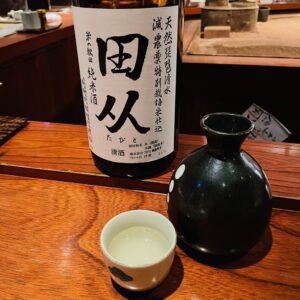
5. Akita Kiritanpoya
After “Toppin Pararinopu”, I went to the reserved “Akita Kiritanpoya”. I had previously checked that “Akita Kiritanpoya” offered Kiritanpo nabe (hotpots) for one person, so I made a reservation to make sure that I could eat Kiritanpo nabe. Since I’m going on a trip to Akita, I wanted to eat Kiritanpo nabe, which is a typical local dish.
However, I regretted having reserved “Akita Kiritanpoya” because “Toppin Pararinopu” also had a Kiritanpo nabe for one person. By the time I went (after 19:00), “Akita Kiritanpoya” was full of customers, and it turned out to be a popular izakaya. However, I personally liked “Toppin Pararinopu” so much that I honestly wanted to stay at “Toppin Pararinopu” instead of going to “Akita Kiritanpoya”.
At “Akita Kiritanpoya”, I ordered “Winter Gakko Nata-zuke”, “Hatahata Shirako (Soft roe)-zuke”, “Hatahata Sashimi”, “Water shield”, and “Kiritanpo nabe“. All are Akita’s local dishes.
“Winter Gakko” means “winter pickles”. “Nata-zuke” is a pickle made by shaving daikon radish with a hatchet, salting it, and then pickling it in amazake. It had a simple taste and was very delicious.

“Hatahata Shirako (Soft roe)-zuke” was the first delicacy I ate. “Hatahata sashimi” was a small sashimi of Hatahata pickled in vinegar.
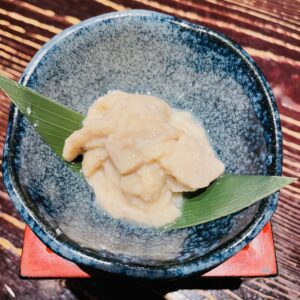

90% of the domestically produced “Water shield” is produced in Mitane Town, Akita Prefecture. Today, 80% of the “Water shield” eaten in Japan is made in China. The smooth texture of “Water shield” was very delicious.

The Kiritanpo nabe had a simple taste and was delicious. Kiritanpo was baked in the hearth. The Ministry of Agriculture, Forestry and Fisheries has selected Kiritanpo Nabe as one of the “100 Best Local Cuisine“. “Kiritanpo” is rice that is mashed with a pestle, squeezed into a stick, and baked.

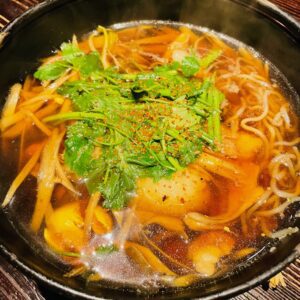
“Akita Kiritanpoya” was a good izakaya that offered above-average delicious meals overall. However, it was too specialized for tourists, such as picture-story shows for customers. In addition, the quality of the part-time job varied widely, and I was worried that the order was being received properly.
Note: The departure / arrival times, fares, admission fees, meal fees, etc. of transportation listed in the text are as of the time of writing the BLOG. Please check for yourself when you go on a trip as it may change in the future.